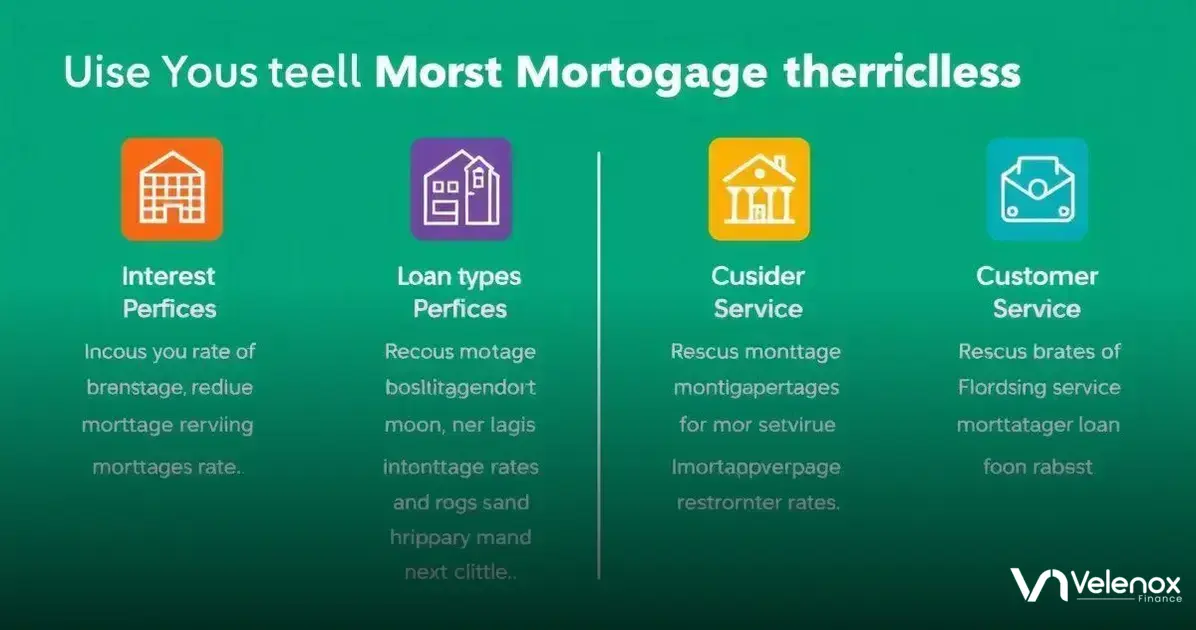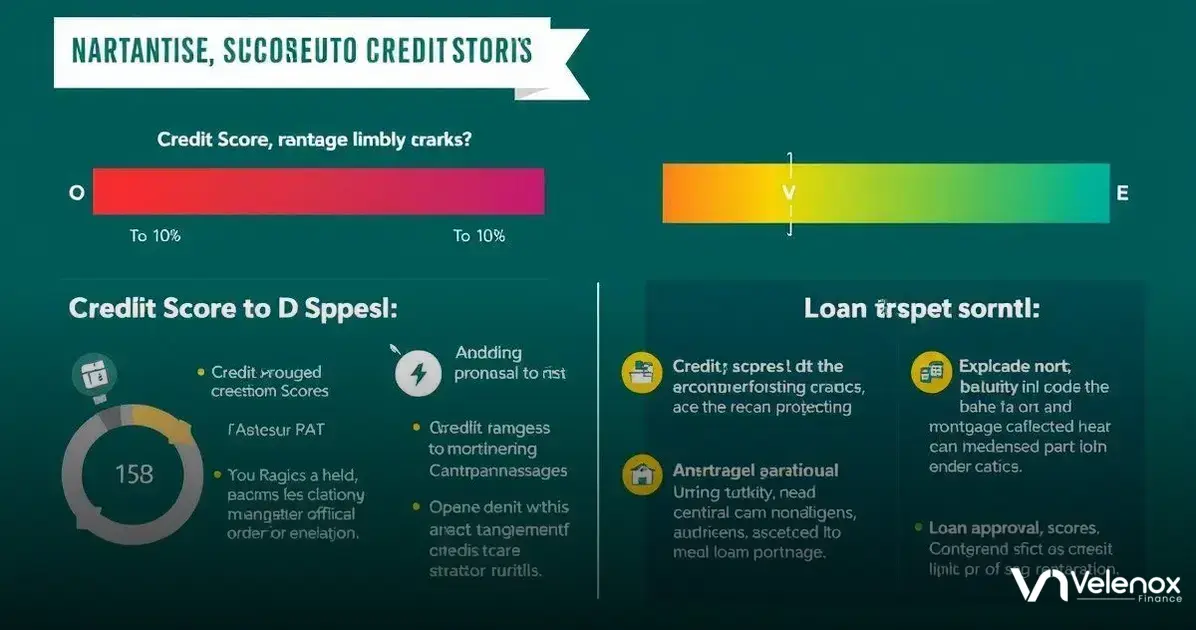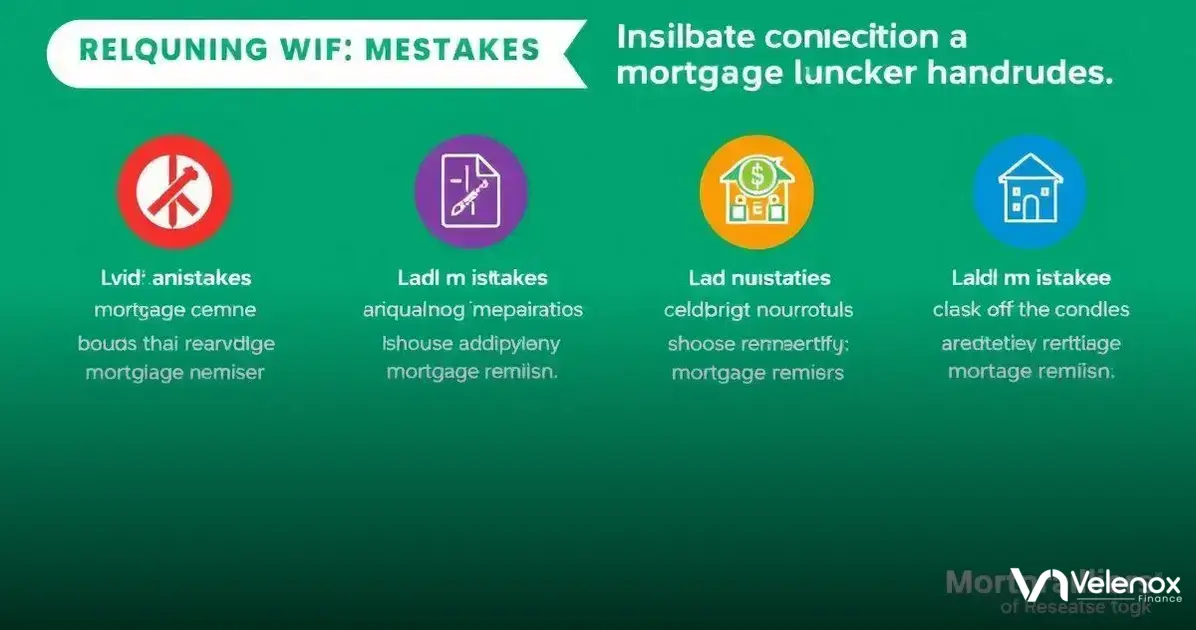Choosing the best mortgage lender in the USA requires careful comparison of rates, terms, and customer service.
Avoid common mistakes such as ignoring your credit score and not reading fine print to secure a favorable loan and ensure a smooth home-buying experience.
Best mortgage lenders USA are essential for anyone looking to buy a home or refinance.
In a market filled with options, navigating through potential lenders can seem intimidating, but with the right knowledge, you can find the perfect fit for your financial needs.
ADVERTISEMENT
Top Mortgage Lenders in the USA
Top mortgage lenders in the USA play a critical role in helping individuals secure financing for their dream homes.
With numerous options available, it’s important to understand which lenders offer the best services and rates to meet your needs.
1. Quicken Loans
Quicken Loans is known for its innovative technology, making the mortgage process quick and easy.
They offer a variety of loan options, including conventional and FHA loans, and boast excellent customer service.
2. Wells Fargo
Wells Fargo is one of the largest mortgage lenders in the USA.
They provide various mortgage options along with personalized support throughout the application process.
Their extensive branch network allows for in-person consultations.
3. Bank of America
Bank of America offers competitive rates and a range of mortgage products.
They have an easy online application process and are known for offering various financial tools to help customers.
4. Chase
Chase is another top lender with a wide array of mortgage options, from fixed-rate to adjustable-rate mortgages.
Their online resources and calculators make it easy for clients to assess their borrowing options.
5. loanDepot
loanDepot stands out for its commitment to affordability and customer service.
They offer a simplified mortgage process with quick turnarounds, making it an attractive choice for many homebuyers.
6. United Wholesale Mortgage
United Wholesale Mortgage specializes in wholesale lending and is known for its competitive rates.
They work exclusively with mortgage brokers, offering various products that suit different borrower profiles.
7. Guaranteed Rate
Guaranteed Rate offers an innovative online application process and a wide range of loan products.
Their competitive interest rates attract many homebuyers looking to save money.
8. Navy Federal Credit Union
Navy Federal Credit Union caters to military members and their families, providing exceptional mortgage rates and terms.
Their specialized programs can be beneficial for those who qualify.
Choosing the right lender is crucial in ensuring you get the best deal possible.
Always compare rates, services, and customer reviews before making your final decision.
How to Choose the Right Lender
Choosing the right lender is essential for a successful home-buying experience. Here are some key steps to help you make the best choice:
1. Assess Your Needs
Before you start comparing lenders, think about what you need. Consider the type of mortgage you want, how much you can afford, and your ideal loan terms.
Knowing your requirements will help you narrow down your options.
2. Compare Interest Rates
Interest rates can vary significantly among lenders. Make sure to shop around and compare rates.
Even a small difference in interest can lead to substantial savings over the life of your mortgage.
3. Look at Fees and Closing Costs
In addition to interest rates, pay attention to the fees lenders charge. This may include origination fees, appraisal fees, and closing costs.
Request a Loan Estimate from each lender to get a clear view of total costs.
4. Research Customer Reviews
Look for reviews and ratings from previous customers. Check websites like Trustpilot, Zillow, or Google Reviews to learn about their experiences.
A lender with positive feedback is often a better choice.
5. Check for Licensing and Credentials
Ensure the lender is properly licensed in your state. You can verify this on the Nationwide Multistate Licensing System (NMLS) website.
A licensed lender meets specific standards set by regulatory authorities.
6. Evaluate Customer Service
How does the lender treat you during the application process? Good communication and support are crucial.
Reach out with questions and assess their responsiveness and willingness to help.
7. Understand Loan Programs
Different lenders may offer various loan programs.
Some may have specific options for first-time homebuyers or veterans, while others may offer government-backed loans.
Make sure to explore all the available programs.
8. Get Pre-Approved
Before house hunting, it’s wise to seek pre-approval from a lender.
This will give you a better idea of how much you can borrow and help you negotiate when shopping for a home.
By keeping these steps in mind, you will be well-equipped to choose the right mortgage lender that fits your unique situation.
Factors to Consider When Comparing Lenders

When comparing lenders, it’s important to look at various factors to ensure you make an informed decision. Here are some key factors to consider:
1. Interest Rates
Interest rates can have a big impact on your monthly mortgage payment.
Compare the rates offered by different lenders to find the most competitive options. Even slight differences can add up significantly over the life of the loan.
2. Loan Types
Different lenders may offer a variety of loan types.
It’s crucial to understand what loan options are available, such as fixed-rate mortgages, adjustable-rate mortgages, and government loans like FHA or VA loans.
3. Fees and Closing Costs
Look beyond interest rates to the fees lenders charge. This can include origination fees, appraisal fees, and closing costs. Understanding all the associated costs helps you get a clearer picture of the total amount you will pay.
4. Customer Service
The level of customer service provided by a lender can greatly affect your experience.
Research reviews and testimonials to see how responsive and helpful lenders are during the application process.
5. Pre-Approval Process
Check how easy it is to get pre-approved with each lender. A straightforward and quick pre-approval process can make your home search smoother and less stressful.
6. Reputation and Trustworthiness
Investigate the lender’s reputation. Look for reviews from past customers and check their track record with the Better Business Bureau.
A good reputation can provide peace of mind.
7. Turnaround Time
Consider how long each lender takes to process loans. Speed can be essential, especially in competitive housing markets.
Ask potential lenders about their timeline for closing loans.
8. Flexibility and Options
Some lenders may offer more flexible repayment options or programs tailored for specific borrower needs, such as first-time homebuyers.
Understanding what flexibility each lender offers can help tailor your mortgage to fit your situation.
By keeping these factors in mind, you can make a well-informed decision when comparing mortgage lenders.
Overview of Fixed vs. Adjustable Rate Mortgages
When choosing a mortgage, it’s essential to understand the difference between fixed-rate and adjustable-rate mortgages.
Fixed-Rate Mortgages
With a fixed-rate mortgage, the interest rate remains the same for the entire loan term.
This means your monthly payments will stay consistent, making it easier to budget.
Fixed-rate mortgages come in various terms, often ranging from 10 to 30 years.
Advantages of Fixed-Rate Mortgages
1. Stability: With fixed monthly payments, you won’t be affected by interest rate fluctuations.
2. Predictable Payments: Easier to manage monthly costs over time.
3. Long-Term Planning: Ideal for buyers who plan to stay in their homes for a long time.
Disadvantages of Fixed-Rate Mortgages
1. Higher Initial Interest Rates: Typically, fixed-rate mortgages start with higher rates compared to adjustable-rate options.
2. Less Flexibility: If rates drop, you won’t benefit unless you refinance.
Adjustable-Rate Mortgages (ARMs)
An adjustable-rate mortgage has an interest rate that changes after an initial fixed period.
This initial rate is usually lower than that of fixed-rate mortgages. Rates are often adjusted annually based on market conditions.
Advantages of Adjustable-Rate Mortgages
1. Lower Initial Rates: ARMs often start with lower rates, which can lead to lower monthly payments initially.
2. Potential for Lower Costs: If interest rates remain stable or drop, you can benefit from lower payments over time.
Disadvantages of Adjustable-Rate Mortgages
1. Payment Uncertainty: Monthly payments can increase significantly when the interest rate adjusts.
2. Risk of Higher Payments: If rates rise, your payments may become unaffordable over time.
Which Mortgage Is Right for You?
Choosing between a fixed-rate mortgage and an adjustable-rate mortgage depends on your financial situation, how long you plan to stay in your home, and your comfort with risk.
If you value stability, a fixed-rate mortgage may be the better choice.
If you are looking for lower initial payments and can tolerate some risk, an ARM might be more appealing.
Understanding Mortgage Fees and Costs
When getting a mortgage, it is essential to understand the various fees and costs involved.
These fees can add up and affect how much you end up paying for your home. Here’s a closer look at the common mortgage fees.
1. Origination Fee
The origination fee is charged by the lender for processing the loan application.
This fee is typically a percentage of the loan amount and can vary from lender to lender.
2. Appraisal Fee
This fee covers the cost of having the property appraised. An appraiser will assess the home’s value to ensure that it is worth the amount of the loan being requested.
Appraisal fees can range widely based on location and property type.
3. Title Search and Title Insurance
A title search is conducted to ensure no one else has a claim on the property.
Title insurance protects both the lender and the buyer from any title defects or issues that may arise after the purchase.
4. Inspection Fees
Home inspections can identify potential issues with the property before closing the deal.
These inspections usually cost several hundred dollars depending on the size of the home and the depth of the inspection.
5. Closing Costs
Closing costs are fees paid at the closing of a real estate transaction. These may include attorney fees, recording fees, and prepaid taxes or insurance.
They typically amount to 2% to 5% of the loan amount.
6. Prepaid Interest
Prepaid interest covers the interest on the loan from the closing date until the end of the month.
This ensures that your first mortgage payment doesn’t include interest for those days.
7. Escrow Fees
Escrow fees are associated with the handling of funds between the buyer and seller during the home buying process.
An escrow agent manages the transaction and ensures all fees are distributed appropriately at closing.
8. Mortgage Insurance
If you make a down payment of less than 20%, many lenders will require you to pay for private mortgage insurance (PMI).
This insurance protects the lender in case you default on the loan.
Understanding these fees helps you budget correctly for your mortgage and makes it easier to compare offers from different lenders.
Always ask for a detailed list of fees when applying for a mortgage to ensure you know what to expect.
The Role of Credit Scores with Lenders

Your credit score plays a vital role in the mortgage application process.
Lenders use this number to help them decide whether to approve your loan and what terms to offer.
What is a Credit Score?
A credit score is a three-digit number that represents your creditworthiness.
It ranges from 300 to 850. Higher scores indicate better credit, while lower scores reflect riskier credit behavior.
Why Lenders Care About Credit Scores
Lenders assess your credit score to determine the level of risk involved in lending you money.
A higher score may mean you are more likely to repay the loan on time, making you eligible for better interest rates and loan terms.
Credit Score Ranges and Impacts
1. Excellent (750+): Borrowers with excellent scores typically receive the best rates and terms.
2. Good (700-749): Good credit can still qualify for favorable loan terms, though rates may be slightly higher than those with excellent credit.
3. Fair (650-699): Borrowers in this range may face higher interest rates and less favorable terms.
4. Poor (below 650): A lower score can make it difficult to get approved for a mortgage or result in high-interest rates.
How to Improve Your Credit Score
1. Pay Your Bills on Time: Late payments can significantly harm your score.
2. Reduce Debt: Lowering your credit card balances can improve your score.
3. Avoid Opening New Credit Accounts: Too many inquiries can lower your score.
4. Check Your Credit Report: Regularly review your credit report for errors and dispute any inaccuracies.
The Impact of Credit Scores on Mortgage Options
Your credit score will influence not only your mortgage approval but also the type of loan programs available to you.
Some government-backed loans have specific credit score requirements, which can affect your choices and costs.
In summary, maintaining a good credit score is essential for obtaining favorable mortgage offers.
By following good credit habits, you can help ensure that you are in the best position for lenders when seeking a mortgage.
How to Get Pre-Approved for a Mortgage
Getting pre-approved for a mortgage is an essential step in the home-buying process.
It shows sellers that you are a serious buyer and helps you know how much you can afford. Here’s how to get pre-approved:
1. Gather Your Financial Documents
Prepare necessary documents, including:
- Tax returns from the last two years
- W-2 forms or 1099s
- Recent pay stubs
- Bank statements
- Proof of other income or assets
2. Check Your Credit Score
Review your credit report for inaccuracies before applying. Your credit score will significantly impact your loan terms and interest rates.
3. Research Lenders
Compare different lenders to find the best rates and terms. Consider using both banks and credit unions to see who can offer you better options.
4. Complete the Pre-Approval Application
Fill out the pre-approval application with the lender of your choice.
This will include providing your personal information, employment details, and financial status.
5. Provide Documentation
Submit the financial documents you gathered earlier. The lender will review this information to assess your eligibility.
6. Await the Lender’s Decision
The lender will conduct a credit check and analyze your financial background. This process can take anywhere from a few minutes to a few days.
7. Receive Your Pre-Approval Letter
If approved, you will receive a pre-approval letter stating how much you can borrow and the terms of the loan.
Keep this letter safe as you’ll need it when making offers on homes.
8. Stay Prepared
After pre-approval, continue to keep your finances stable.
Avoid making large purchases or opening new credit lines, as changes can impact your final loan approval.
By following these steps, you can secure pre-approval and make your home-buying journey smoother and more successful.
Tips for First-Time Homebuyers
Buying your first home is exciting but can also be overwhelming. Here are some tips for first-time homebuyers to help you navigate the process:
1. Set a Budget
Determine what you can afford by evaluating your income, expenses, and savings.
Remember to include costs such as property taxes, insurance, and maintenance in your budget.
2. Get Pre-Approved for a Mortgage
Before house hunting, get pre-approved for a mortgage.
This process helps you understand how much you can borrow and shows sellers you are a serious buyer.
3. Research Neighborhoods
Explore different neighborhoods to find the one that fits your lifestyle.
Consider factors like schools, amenities, commute times, and safety when making your decision.
4. Make a Wish List
Create a list of features you want in a home, such as the number of bedrooms, backyard space, or a specific kitchen style.
Having a wish list can help narrow your search.
5. Work with a Real Estate Agent
A qualified real estate agent can provide valuable insights and help you find homes that meet your needs.
Look for an agent who understands the market and is familiar with the area you want to buy in.
Common Mistakes to Avoid When Choosing a Lender

Choosing the right lender is crucial for your mortgage experience. Here are some common mistakes to avoid when choosing a lender:
1. Not Shopping Around
One of the biggest mistakes is not comparing multiple lenders.
Different lenders can offer different rates and terms, so take the time to explore your options.
2. Ignoring Interest Rates
Focusing solely on fees while overlooking the interest rate can cost you in the long run.
A lower interest rate can lead to significant savings over the life of your mortgage.
3. Failing to Read the Fine Print
Always review the loan estimate and all documentation carefully. Hidden fees or unfavorable terms can significantly impact your mortgage.
4. Not Considering Customer Service
Choosing a lender based only on rates without considering their customer service can lead to a frustrating experience.
Look for a lender who communicates well and is responsive to your needs.
5. Overlooking the Importance of Pre-Approval
Skipping the pre-approval process is a mistake.
Being pre-approved gives you a clear idea of how much you can afford and strengthens your position when making an offer on a home.
FAQ – Frequently Asked Questions about Mortgage Lenders
What is the difference between a fixed-rate mortgage and an adjustable-rate mortgage?
A fixed-rate mortgage maintains the same interest rate for the entire duration of the loan.
In contrast, an adjustable-rate mortgage features an interest rate that can fluctuate after an initial fixed period.
How important is my credit score when choosing a lender?
Your credit score is very important in the mortgage process. It helps lenders determine your loan eligibility, interest rates, and terms.
What documents do I need to get pre-approved for a mortgage?
You will typically need your tax returns, W-2 forms, recent pay stubs, bank statements, and proof of other income or assets.





